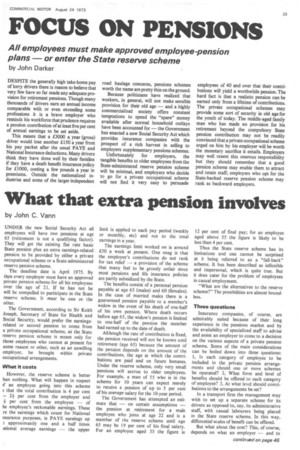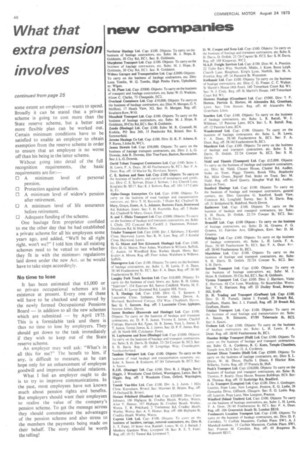What that extra pension involves
Page 27

Page 48

If you've noticed an error in this article please click here to report it so we can fix it.
by John C. Vann
UNDER the new Social Security Act all employees will have two pensions at age 65 (retirement is not a qualifying factor). They will get the existing flat rate basic State pension plus an extra earnings-related pension to be provided by either a private occupational scheme or a State-administered reserve pension scheme.
The deadline date is April 1975. By then every employer must have an approved private pension scheme for all his employees over the age of 21. If he has not he will be compelled to participate in the State reserve scheme. It must be one or the other.
The Government, according to Sir Keith Joseph, Secretary of State for Health and Social Security, would prefer the earningsrelated or second pension to come from a private occupational scheme, as the State reserve pension scheme is meant only for those employees who cannot at present for some reason or other, such as an unwilling employer, be brought within private occupational arrangements.
What it costs
However, the reserve scheme is better han nothing. What will happen in respect pf an employee going into this scheme 3 that the total contribution is 4 per cent — 2+ per cent from the employer and + per cent from the employee — of he employee's reckonable earnings. These re the earnings which count for National nsurance purposes, ie PAYE earnings up 3 approximately one and a half times ational average earnings — the upper
limit is applied to each pay period (weekly or monthly, etc) and not to the total earnings in a year.
The earnings limit worked on is around £50 a week at present. One snag is that the employee's contributions do not rank for tax relief — a provision of the scheme that many feel to be grossly unfair since most pensions and life insurance policies are partly subsidized by the State.
The benefits consist of a personal pension payable at age 65 (males) and 60 (females). In the case of married males there is a guaranteed pension payable to a member's widow in the event of his death of one-half of his own pension. Where death occurs before age 65, the widow's pension is limited to one-half of the pension the member had earned up to the date of death.
Although the rate of contribution is fixed, the pension received will not be known until retirement (age 65) because the amount of the pension depends on the amount of the contributions, the age at which the contributions are paid and on future bonuses. Under the reserve scheme, only very small pensions will accrue to older employees. For example, a man of 55 who is in the scheme for 10 years can expect merely to receive a pension of up to 5 per cent of his average salary for the 10-year period.
The Government has attempted an estimate that — on certain assumptions — the pension at retirement for a male employee who joins a't age 22 and is a member of the reserve scheme until age 65 may be 19 per cent of his final salary. For an employee aged 35 the figure is 12 per cent of final pay: for an employee aged above 55 the figure is likely to be less than 4 per cent.
Thus the State reserve scheme has its limitations and one cannot be surprised at it being referred to as a "fall-back" scheme. It has been described as inflexible and impersonal, which is quite true. But it does cater for the problem of employees in casual employment.
"What are the alternatives to the reserve scheme?" The possibilities are almost boundless.
Three questions
Insurance companies, of course, are admirably suited because of their long experience in the pensions market and by the availability of specialized staff to advise and assist an employer to come to a decision on the various aspects of a private pension scheme. Some of the main considerations can be boiled down into three questions: 1, Is each category of employee to be included in the private pension arrangements and should one or more schemes be operated? 2, What form and level of benefits should be offered to each category of employee? 3, At what level should contributions to the arrangements be set?
In a transport firm the management may wish to set up a separate scheme for its drivers as opposed to, say, its administrative staff, with casual labourers being placed in the State reserve scheme. In this way, differential scales of benefit can be offered.
But what about the cost? This, of course, depends on what an employer — and to some extent an employee wants to spend.
Broadly it can be stated that a private scheme is going to cost more than the State reserve scheme, but a better and more flexible plan can be worked out. Certain minimum conditions have to be satisfied to enable an employer to obtain exemption from the reserve scheme in order to ensure that an employee is no worse off than his being in the latter scheme.
Without going into detail of the full recognition requirements, the basic requirements are for: El A minimum level of persona! pension. o Protection against inflation.
O A minimum level of widow's pension after retirement.
O A minimum level of life assurance before retirement.
O Adequate funding of the scheme.
One haulage firm proprietor confided to me the other day that he had established a private scheme for all his employees some years ago, and added, "We'll be all right right, won't we?" I told him that all existing schemes need to be vetted to see whether they fit in with the minimum regulations laid down under the new Act. so he would have to take steps accordingly.
No time to lose It has been estimated that 65,000 or so private occupational schemes are in existence at present. Every one of these will have to be checked and approved by the newly formed Occupational Pensions Board in addition to all the new schemes which are submitted by April 1975. This is a formidable task and there is thus no time to lose by employers. They should get down to the task immediately if they wish to keep out of the State reserve scheme.
An employer may well ask: "What's in all this for me?" The benefit to him, if any, is difficult to measure, as he can hope only for an enhancement of employee goodwill and improved industrial relations.
What I feel an employer ought to do is to try to improve communications. In the past, most employees have not known much about pension rights and benefits. But employers should want their employees to realize the value of the company's pension scheme. To get the message across they should communicate the advantages of the pension scheme and also stress to the members the payments being made on their behalf. The story should be worth the telling!




















































































